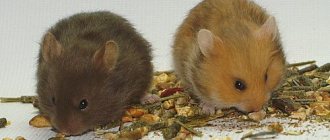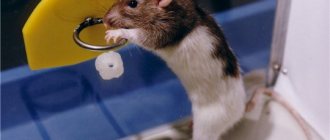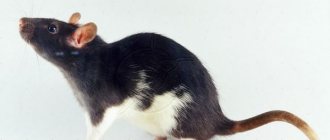Prohibited Products
Any prepared food, especially fried or spicy food, is prohibited for rats; canned food; sweet; alcoholic drinks; sweet drinks.
It is also undesirable to feed your pet from the owner's table: the food sold in specialized stores is already balanced and includes all the necessary vitamins. If you give your pet food from the table, the animal may refuse its food. Afterwards, it will be very difficult to wean the animal off junk food.
If you want to pamper your pet with fruits or vegetables, it is very important that they are in season, otherwise there is a risk of poisoning from harmful pesticides that are used for quick growing and long-term storage.
Grains and cereals - which ones should you avoid?
Grains form the main diet of rats, but it is necessary to know which grains can be fed and which cannot.
- Wheat is allowed for rats, but requires supplementation with other types of grains. Very high in calories. Wheat can be diluted with rice, buckwheat, corn and other grains.
- Buckwheat is considered dietary, has few calories, and can be added to the diet of rats.
- Corn, on the contrary, is high in calories; it is advisable to give it less often than others and as an additive to other grains.
- Oats - can cause fermentation, so it can be given, but in small quantities.
- Rice is considered to have little nutritional value, so it is advisable to feed either wild or brown rice.
- Semolina does not contain anything beneficial for the rat’s body, and veterinarians advise excluding it from the diet.
- Millet or barley - they can be given in the form of ready-made porridge for weakened animals, or for nursing offspring; adults can sometimes be given for variety.
What do you feed domestic rats: diet composition
A high-quality grain mixture is the basis of the diet of domestic rats. The easiest way is to choose ready-made high-quality food rather than making the mash yourself. Food is given ad libitum, without restrictions. An adult rat eats about 30 grams per day.
In addition to grain, the rat menu must include succulent food - vegetables or fruits, green salads. Protein complementary foods are also needed, especially for young animals during the growth period, pregnant or lactating females.
As a reward for training and just to pamper your pets, they use various seeds and nuts, unsweetened popcorn, banana chips and much more. Treats should make up a tiny part of the diet.
Why does it smell so good?
Domestic rats are fed something like this:
- 60% grain mixture (feed)
- 20% vegetables and unsweetened fruits, greens
- 10% protein food (meat, eggs)
- 5% fermented milk products
- 5% treats
Example of a diet for rats: dry food on the right, protein and succulent food on the left
Now let's take a closer look at each section.
Vegetables and greens
Vegetables are very healthy and are allowed to be consumed daily, but in small quantities.
- Cabbage - any kind is undesirable for consumption, because... causes fermentation.
- Broccoli – can be given as an occasional treat.
- Radishes/turnips/radishes and some legumes (beans, lentils) cause increased discomfort due to gas formation, so their consumption is undesirable.
- Carrots/zucchini/pumpkin are very healthy, rich in vitamins, so their consumption is recommended.
- Eggplants/artichokes – only boiled ones are allowed; when cooking for an animal, adding salt or spices is not required.
- Cucumbers/beets – can cause stomach upsets in the form of diarrhea, so their consumption is undesirable.
- Potatoes have no value and are even prohibited in their raw form.
- Dill/parsley/celery, etc. are very beneficial for the digestion of rats, so it is advisable to add greens to their food daily.
- Tomato/sorrel – contain acid, consumption by rats is undesirable.
Treats for rats: a little of each
Training animals is incredibly interesting; rats successfully learn various commands. The question arises - how to encourage pets so as not to harm them. And in everyday life, sometimes you want to pamper rats with something tasty.
The main rule: the treat should not be sweet. Therefore, I urge you not to buy “treats” for rodents at the pet store! Milk drops, honey sticks and other crap can be harmful to the health of rats. Moreover, no less tasty things can be found at home.
This cookie is obviously too big
Rats love seeds and nuts! They are given individually, literally one at a time, 1-2 times a week. The point is high fat content and calorie content. Seeds and nuts should not be fried or salted.
- Watermelon, pumpkin, sunflower, flax seeds, sesame seeds;
- Walnuts, hazelnuts, cashews, peanuts.
Rats love all kinds of seeds, but this is too fatty food for them
As a reward, you can use treats made from cereals and cereals:
- Pieces of cereal, unless they are sweet (corn, wheat);
- Tiny crackers dried from regular bread;
- Unsweetened cookies (biscuits);
- Homemade popcorn or puffed rice;
- Pieces of rice paper;
- Pasta;
- Porridges from various cereals.
For repeated rewards, you can dip a stick in yogurt or baby puree and let your rat lick it.
Dumbo rat eats corn
Fruits
- Citrus fruits are prohibited for consumption, because may cause allergic reactions due to increased acidity. A piece of tangerine is allowed as a treat (sometimes).
- Forest/garden berries – the acidity of the berry must be taken into account. Cranberry is very useful, but you need to give it a little and watch the reaction.
- Pear – may cause fermentation, should be given occasionally.
- Plum – has a laxative effect, its use in the diet of rats is undesirable.
- Watermelon/melon – a small amount is allowed, but must be seasonal.
- Dried fruits can also provoke fermentation; they are given occasionally as a tasty treat.
It is important to know that eating seeds from berries and fruits is unacceptable; they are very harmful to animals and can cause poisoning.
Can rats eat meat: about protein feeding
Unlike rabbits or guinea pigs, rats are omnivores. A strictly vegetarian diet is bad for their well-being. Adult rats should be given protein-rich food 1-2 times a week, while young rats up to 5 months old should receive it 3-4 times a week.
Many people ask whether rats can eat meat, because they fear that the animal will become “bloodthirsty”, bite fingers, bite a cat, and the like. All these fears are groundless, rats do not become aggressive from meat, and it is necessary to give it. Although rats are delighted with such food, moderation must be observed - a serving of animal protein for an adult rodent is about 20 grams.
Juicy and protein complementary foods in one bowl
The following are used as protein foods:
- Lean boiled meat (beef, turkey, chicken, rabbit)
- Boiled eggs (quail or chicken);
- Boiled fish, squid or shrimp;
- Live and dried insects: grasshoppers, gammarus, zofobas, mealworms.
It is better to give out the meat individually so that the rats do not fight over the tasty morsel. Otherwise, particularly arrogant rats will receive protein overfeeding, while others will experience a lack of nutrients. They serve strictly boiled, not raw meat.
When there are a lot of rats: everyone gets a chicken leg!
As for eggs: boiled yolk can cause a rat to choke. To avoid this, boil the egg soft-boiled or mix the yolk with water. Quail eggs can be given unshelled; rats will eat or peel the shell at their discretion.
Quail eggs are given to rats not because of some “magical properties”, but because of their convenient size
Fish and seafood are rarely given, since these products give urine an unpleasant, specific odor.
Opinions differ regarding insects - there are fears that they can serve as a source of helminthic infestation. However, this is only true for live worms; dried insects are safe. For my part, I agree that it is easier and safer to give your pets a boiled quail egg or a piece of breast than to look for and buy all sorts of larvae.
Milk products
All dairy products will be beneficial to your rat's health, but it is important to be aware of the possibility of a lactose allergy. It is advisable not to give pure milk, but other fermented milk can be given, but without fanaticism, you need to introduce new products little by little, observing the reaction. It is also undesirable to consume homemade sour cream/cream/cheese; often such products have a high fat content, which can cause digestive disorders.
Possible and useful:
- cottage cheese;
- fermented baked milk;
- pure yogurt;
- kefir.
Any fermented milk product should have no more fat than 4%. When it comes to low-fat products, it is advisable to choose non-perishable or children's dairy products.
Rat food: which one is better?
Grain mixture is the basis of the diet of domestic rats. I advise you to buy only high-quality food, and if this is not possible, prepare the mixture yourself. Unfortunately, domestic inexpensive food has a very poor composition. They consist mainly of oats.
I categorically do not recommend buying food that is stored in cardboard boxes (not airtight), especially in hypermarkets. A rat can easily be poisoned by such food if it was standing, for example, next to washing powder. Opt for imported food in sealed packaging.
Of the two foods, the choice is obvious in favor of Little One, although this is far from the best food for rats
Here are some high-quality foods that can be safely offered to decorative rats:
- Versel-Laga Rat Nature;
- Vitacraft Menu Vital;
- Beaphar Xtra Vital Rat or Care+ Rat Food;
- Vitapol Karma Premium;
- JR Farm Ratten-Schmaus.
Please note that in addition to regular grain mixtures, there are granulated foods for rats. They are similar to complete food for cats and dogs - homogeneous solid “crackers”. Granular feed does not differ from regular feed in composition. They are convenient in the case of selective eating - if rats select seeds and other goodies from the food, leaving the grain uneaten.
Rat food
The basis of the diet should always be cereals: wheat, rye, barley, oats.
What should a rodent not eat?
There are products
, the presence of which in a rat’s diet is extremely undesirable. It is not recommended to give beets in any form to your pet, as this fruit can cause diarrhea in the rodent. Eating grapes can cause increased gas formation in the rat's intestines, so this fruit should not be given to the animal. Also, the rat should not be fed spinach, products containing soy and cocoa.
It is not recommended to give your rodent any boiled cereals, since their consumption can lead to the animal gaining excess weight. If you want to pamper your pet with porridge, then pour boiling water over the cereal, let it sit, cool, and only then give it to the rat.
It should be remembered that some plant foods can even kill an animal, and in this case we are talking about poisonous indoor plants. If you have flowers at home such as potted stools, dieffenbachia, begonia, cyclamen and azalea, then you need to be especially careful to ensure that the rat does not approach these plants.
It is not advisable to give your rat watermelon and melon, especially if these are early fruits. Store-bought melons may contain large amounts of nitrates, the consumption of which can result in the death of the rodent. Therefore the animal can eat
only homemade fruits and vegetables.
It should be taken into account that eating spoiled food can negatively affect the health of the rat, so the cage where the pet lives must be cleaned regularly.
If the animal has any problems
with health, then it should be immediately shown to a veterinarian, and not practice independent treatment of the rodent. The latter can lead to worsening health problems for your pet.
Got a new pet in your home? It's time to find out what to feed your rat, what food you can give it and what is strictly forbidden, what you can treat it to occasionally, and what it can eat without any restrictions. Although rats are not particularly picky about food, you cannot feed them “just anything.” Their diet should be balanced and food properly prepared.
The most effective traps
Several of the most effective methods are used to control pests. These are poisonous baits, ultrasonic repellers, mousetraps that kill or catch animals alive, and sticky traps.
Each method has its own characteristics, advantages and disadvantages. To choose the appropriate option, you should consider them in more detail.
Poison traps
Placed in places closest to nests or movement routes of animals. Often made from seeds or grains. Rodenticides can be purchased at pharmacies.
The drugs are made on the basis of substances that block blood clotting. As a result, rodents die from internal bleeding. Such baits should not be used in areas where pets live.
Ultrasonic repellers
This method is considered the most humane and safe for both animals and humans. Such devices produce sounds at a certain frequency.
For humans they are imperceptible, but for rats they are simply unbearable . Some models, in addition to ultrasound, are capable of emitting special sound signals and scaring away beepers using light flashes.
The combination of several effects completely kills the desire of pests to be near such powerful stimuli. In the first few days of using repellers, an increase in the number of rats may be observed, but do not be alarmed, this is a normal reaction.
Ultrasound causes real panic in pasyuki, forcing them to be active during the daytime and chaotic movements around the house. In a couple of weeks the room will be completely cleared of parasites.
Another safe and humane way to control rodents is with essential oils. Animals simply cannot stand the smell of mint and try to stay away from it.
Rat traps
If there are a lot of pests, you can try to catch them with a rat trap. To do this, you need to use the best baits that were listed above.
When setting traps, it is important to ensure that there are no small children or pets nearby.
Compared to poisons, mousetraps have undeniable advantages . A poisoned rat can die anywhere in the house. The corpse under the floor will poison the air with an unpleasant odor for a long time.
Traps with bait for rats are located along the walls, in areas where rodents or traces of their presence have been noticed. Typically traps are placed perpendicular to the wall.
In addition to devices that kill animals, there are also so-called “live traps”. They confine the animal without injuring it. This allows you to release the rat into the wild, the main thing is to do it away from your home.
Sticky traps
Usually used for catching mice, since their weight is much less than that of a rat. The animal, running along its usual routes, ends up on a sticky surface from which it cannot get out.
If such a trap is glued to the body of a person or pet, it can be removed using vegetable oil.
The installed traps are checked every day. All manipulations must be carried out with rubber gloves.
Supplements
Let special mineral stones for rodents be in the cage. If the animal needs them, he will use them. Here you can also remember about onions and garlic.
The normal feeding frequency is twice a day - for adults, three to four times for children and adolescents.
Photo on Foter.com
You cannot overfeed a rat.
If an animal does not want to eat any product, do not force it! Offer a replacement.
Introduce new foods for the animal into the diet a little at a time, watch the animal’s reaction, changes in its condition and behavior.
Each animal has its own individual characteristics.











